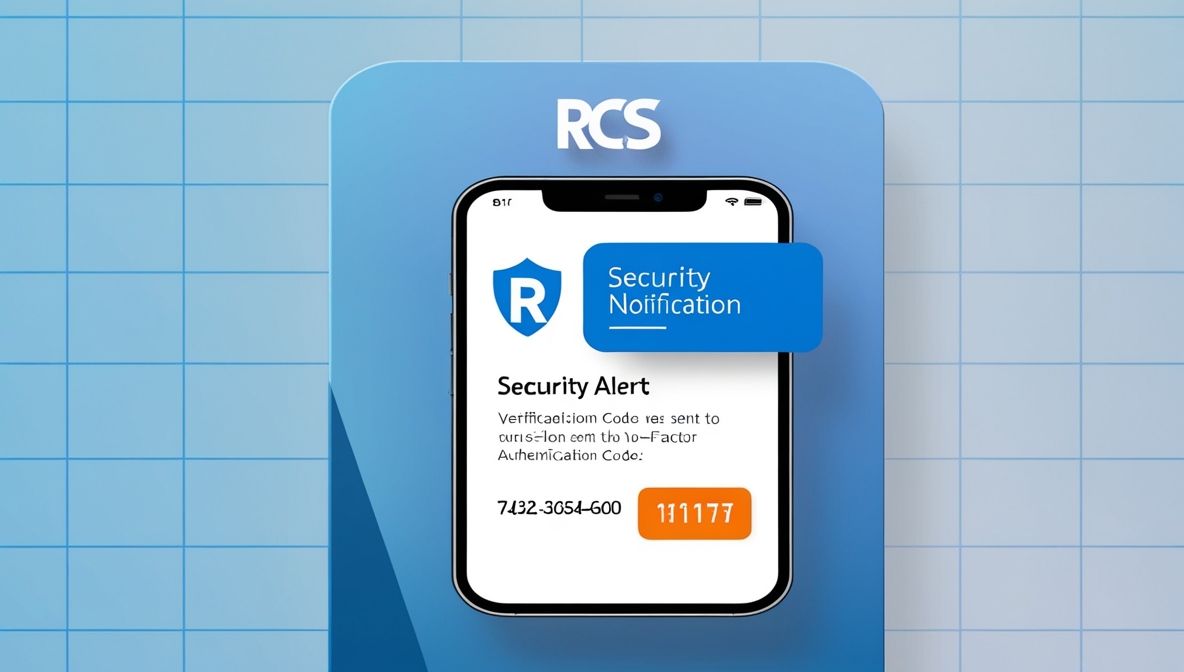As cyber threats evolve, businesses are constantly searching for ways to improve digital security and protect user data. One of the most common and effective methods for enhancing security is Two-Factor Authentication (2FA)—a process that requires users to verify their identity through an additional step, typically involving a one-time password (OTP). Traditionally, SMS has been the go-to channel for delivering these codes. However, a new player is emerging: RCS message.
Rich Communication Services (RCS), the modern upgrade to SMS, offers a more secure, interactive, and branded experience that is proving to be an excellent fit for 2FA and other types of security alerts. As more Android devices adopt RCS, its potential in secure communications is gaining serious momentum.
In this article, we’ll explore how RCS works, how it enhances 2FA and security notifications, and why businesses should consider adopting it as part of their digital security strategy.
What Is RCS Messaging?
RCS (Rich Communication Services) is a next-gen messaging protocol developed to replace SMS. Unlike SMS, which is limited to plain text, RCS supports rich media, branded content, suggested replies, read receipts, and encryption (in some implementations). RCS messaging feels more like using a messaging app—such as WhatsApp or iMessage—but it’s built into the native Android Messages app on supported devices.
Google has taken the lead in pushing global adoption of RCS, and it is now supported by many carriers and device manufacturers around the world.
Why RCS Is a Game Changer for 2FA
Two-Factor Authentication typically uses a secondary communication method to verify the identity of the user. The most common method has been to send a one-time password (OTP) via SMS. However, SMS has known vulnerabilities, including:
- SIM swapping attacks
- SMS interception
- Lack of message encryption
- Easily spoofed sender information
RCS mitigates several of these issues and enhances the user experience in key ways:
- Verified Sender Identity
Unlike SMS, where almost anyone can spoof a phone number, RCS supports verified sender IDs. This means the recipient can see the sender’s name, logo, and verification checkmark—reducing the risk of phishing or impersonation.
- Branded and Trusted Interface
2FA via RCS allows businesses to deliver OTPs and security alerts in a branded environment. This reassures users that they’re interacting with a trusted entity, making them less likely to fall for fraudulent messages.
- Encrypted Channels
While RCS doesn’t offer end-to-end encryption across all carriers, messages are often sent through secure channels, providing a higher level of protection than SMS. Some implementations also include transport layer encryption to prevent interception.
- Read Receipts and Delivery Confirmation
For security teams, it’s critical to know whether a 2FA message was received and read. RCS offers delivery and read receipts, giving businesses more visibility into the status of each security communication.
- Interactive Authentication
RCS can go beyond simple OTP delivery. It supports interactive buttons and quick replies, allowing users to confirm actions, report suspicious activity, or request a new code—all within the same message thread.
Security Alerts: RCS in Action
Security alerts are another area where RCS shines. Think of scenarios like:
- Unusual login attempt
- Password change notifications
- Account recovery prompts
- Suspicious transaction alerts
With RCS, these alerts can be transformed into visually engaging, real-time notifications. For example, a security alert might include:
- A message explaining the action (e.g., “New login from an unfamiliar device.”)
- A map or image showing the login location
- Buttons like “It Was Me” or “Report This”
- Direct access to support or account settings
This level of interaction helps users act faster and reduces the risk of account breaches going unnoticed.
RCS vs SMS for Security Use Cases
| Feature | RCS | SMS |
|---|---|---|
| Verified Sender ID | ✔ | 🗶 |
| Rich Media Support | ✔ | 🗶 |
| Encryption (Transport Layer) | ✔ | 🗶 |
| Read Receipts | ✔ | 🗶 |
| Branded Messaging | ✔ | 🗶 |
| Interactive Buttons | ✔ | 🗶 |
| Spoofing Resistant | ✔ | 🗶 |
While SMS is still widely used, it’s increasingly seen as outdated and insecure, particularly for high-stakes communication like 2FA. RCS offers the next level of protection and usability.
Integration and Deployment
Businesses looking to integrate RCS for 2FA and security alerts can do so through RCS Business Messaging platforms, often provided by Messaging-as-a-Service (MaaS) companies. These platforms offer APIs and dashboards that allow:
- Automation of OTP delivery
- Triggering security messages based on user activity
- Integration with identity management systems
- Analytics for monitoring delivery and engagement
For global outreach, many businesses choose to use RCS alongside WhatsApp Business API and fallback to SMS in regions where RCS is not yet fully supported.
Use Case: RCS for Financial Services
Let’s take a real-world example. A digital bank using RCS for 2FA can send customers a branded message with:
- Their logo and bank name at the top
- A time-sensitive OTP with a 6-digit code
- A security tip reminding the user not to share the code
- A button labeled “I didn’t request this” that links to account security
In the case of an unusual login attempt, the user could receive:
- A map showing the login location
- Device info (browser, OS)
- A “Secure My Account” button to quickly lock down the account
This level of detail and interactivity is impossible with SMS and far more reassuring for users.
Challenges and Considerations
While RCS is powerful, there are still a few limitations:
- Limited to Android: Apple does not yet support RCS. Messages to iPhone users would still need to be sent via SMS or apps like WhatsApp.
- Carrier and Device Compatibility: Not all Android phones or networks support RCS yet. Businesses may need fallback options.
- End-to-End Encryption: Unlike WhatsApp, most RCS implementations don’t yet support full end-to-end encryption, although Google has made progress here in 1:1 chats.
Despite these challenges, the benefits of RCS—especially in environments where it is fully supported—are compelling.
Future Outlook
With Google pushing RCS adoption, support continuing to grow across carriers, and security threats becoming more sophisticated, the use of RCS for 2FA and security alerts is set to expand rapidly.
As users become more aware of digital threats, they’ll begin to demand more secure and transparent ways to interact with brands. RCS offers just that—a modern, trustworthy channel that’s tailor-made for sensitive interactions like 2FA.
RCS messaging represents the future of secure, user-friendly communication. For businesses looking to protect their users while delivering a seamless experience, integrating RCS into their 2FA and security alert workflows is a smart, forward-thinking move.
By combining better branding, greater interactivity, and improved security, RCS outclasses SMS and opens new doors for safeguarding user data. As adoption grows, businesses that embrace RCS today will be better positioned to deliver trust-driven experiences tomorrow.





